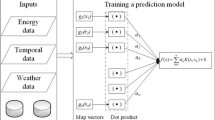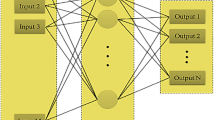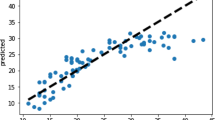Abstract
This study develops an approach consisting of a stacking model integrated with a multi-objective optimisation algorithm aimed at predicting and optimising the ecological performance of buildings. The integrated model consists of five base models and a meta-model, which significantly improves the prediction performance. Specifically, the R2 value was improved by 9.19% and the error metrics MAE, MSE, MAPE, and CVRMSE were reduced by 69.47%, 79.88%, 67.32%, and 57.02%, respectively, compared to the single prediction model. According to the research on interpretable machine learning, adding the SHAP value gives us a deeper understanding of the impact of each architectural design parameter on the performance. In the multi-objective optimisation part, we used the NSGA-III algorithm to successfully improve the energy efficiency, daylight utilisation and thermal comfort of the building. Specifically, the optimal design solution reduces the energy use intensity by 31.6 kWh/m2, improves the useful daylight index by 39%, and modulated the thermal comfort index, resulting in a decrement of 0.69 °C for the summer season and an enhancement of 0.64 °C for the winter season, respectively. Overall, this study provides building designers and decision makers with a tool to make better design decisions at an early stage to achieve a better combination of energy efficiency, daylight utilisation and thermal comfort optimisation in an integrated manner, providing an important support for achieving sustainable building design.
Similar content being viewed by others
References
Amasyali K, El-Gohary NM (2018). A review of data-driven building energy consumption prediction studies. Renewable and Sustainable Energy Reviews, 81: 1192–1205.
Bellahsen A, Dagdougui H (2021). Aggregated short-term load forecasting for heterogeneous buildings using machine learning with peak estimation. Energy and Buildings, 237: 110742.
Bröde P, Fiala D, Błażejczyk K, et al. (2012). Deriving the operational procedure for the Universal Thermal Climate Index (UTCI). International Journal of Biometeorology, 56: 481–494.
Chang X, Li W, Ma J, et al. (2020). Interpretable machine learning in sustainable edge computing: a case study of short-term photovoltaic power output prediction. In: Proceedings of ICASSP 2020–2020 IEEE International Conference on Acoustics, Speech and Signal Processing (ICASSP), Barcelona, Spain.
Chegari B, Tabaa M, Simeu E, et al. (2021). Multi-objective optimization of building energy performance and indoor thermal comfort by combining artificial neural networks and metaheuristic algorithms. Energy and Buildings, 239: 110839.
Chen K, Jiang J, Zheng F, et al. (2018). A novel data-driven approach for residential electricity consumption prediction based on ensemble learning. Energy, 150: 49–60.
Chen R, Tsay Y-S, Ni S (2022). An integrated framework for multi-objective optimization of building performance: Carbon emissions, thermal comfort, and global cost. Journal of Cleaner Production, 359: 131978.
Cherp A, Jewell J, Goldthau A (2011). Governing global energy: Systems, transitions, complexity. Global Policy, 2: 75–88.
Chi DA, Moreno D, Navarro J (2017). Design optimisation of perforated solar façades in order to balance daylighting with thermal performance. Building and Environment, 125: 383–400.
Choi Y, Song D, Yoon S, et al. (2021). Comparison of factorial and Latin hypercube sampling designs for meta-models of building heating and cooling loads. Energies, 14: 512.
Crawley DB, Lawrie LK, Winkelmann FC, et al. (2001). EnergyPlus: creating a new-generation building energy simulation program. Energy and Buildings, 33: 319–331.
Deb K, Jain H (2014). An evolutionary many-objective optimization algorithm using reference-point-based nondominated sorting approach, Part I: Solving problems with box constraints. IEEE Transactions on Evolutionary Computation, 18: 577–601.
Digital Structures (2017). Design Space Exploration. Available at https://www.food4rhino.com/en/app/design-space-exploration. Accessed 22 Aug 2023
Divina F, Gilson A, Goméz-Vela F, et al. (2018). Stacking ensemble learning for short-term electricity consumption forecasting. Energies, 11: 949.
Escandón R, Ascione F, Bianco N, et al. (2019). Thermal comfort prediction in a building category: Artificial neural network generation from calibrated models for a social housing stock in southern Europe. Applied Thermal Engineering, 150: 492–505.
Fan C, Xiao F, Yan C, et al. (2019). A novel methodology to explain and evaluate data-driven building energy performance models based on interpretable machine learning. Applied Energy, 235: 1551–1560.
Fang Y, Cho S (2019). Design optimization of building geometry and fenestration for daylighting and energy performance. Solar Energy, 191: 7–18.
Gao W, Huang X, Lin M, et al. (2022). Short-term cooling load prediction for office buildings based on feature selection scheme and stacking ensemble model. Engineering Computations, 39: 2003–2029.
Hamdy M, Nguyen A-T, Hensen JLM (2016). A performance comparison of multi-objective optimization algorithms for solving nearly-zero-energy-building design problems. Energy and Buildings, 121: 57–71.
Ho YC, Pepyne DL (2002). Simple explanation of the No-free-lunch theorem and its implications. Journal of Optimization Theory and Applications, 115: 549–570.
Kirimtat A, Krejcar O, Ekici B, et al. (2019). Multi-objective energy and daylight optimization of amorphous shading devices in buildings. Solar Energy, 185: 100–111.
Konis K, Gamas A, Kensek K (2016). Passive performance and building form: An optimization framework for early-stage design support. Solar Energy, 125: 161–179.
Li H, Qiu P, Wu T (2021). The regional disparity of per-capita CO2 emissions in China’s building sector: An analysis of macroeconomic drivers and policy implications. Energy and Buildings, 244: 111011.
Liu K, Xu X, Huang W, et al. (2023). A multi-objective optimization framework for designing urban block forms considering daylight, energy consumption, and photovoltaic energy potential. Building and Environment, 242: 110585.
López-Cabeza VP, Diz-Mellado E, Rivera-Gómez C, et al. (2022). Thermal comfort modelling and empirical validation of predicted air temperature in hot-summer Mediterranean courtyards. Journal of Building Performance Simulation, 15: 39–61.
Lu M, Lai JHK (2019). Building energy: A review on consumptions, policies, rating schemes and standards. Energy Procedia, 158: 3633–3638.
Ma Z, Wang P, Gao Z, et al. (2018). Ensemble of machine learning algorithms using the stacked generalization approach to estimate the warfarin dose. PLoS One, 13: e0205872. [PubMed]
Mohammed AS, Asteris PG, Koopialipoor M, et al. (2021). Stacking ensemble tree models to predict energy performance in residential buildings. Sustainability, 13: 8298.
Nabil A, Mardaljevic J (2005). Useful daylight illuminance: A new paradigm for assessing daylight in buildings. Lighting Research & Technology, 37: 41–57.
Pan Y, Zhu M, Lv Y, et al. (2023). Building energy simulation and its application for building performance optimization: A review of methods, tools, and case studies. Advances in Applied Energy, 10: 100135.
Pavlyshenko B (2018). Using stacking approaches for machine learning models. In: Proceedings of 2018 IEEE Second International Conference on Data Stream Mining & Processing (DSMP).
Polikar R (2012). Ensemble learning. In: Zhang C, Ma Y (eds), Ensemble Machine Learning. New York: Springer.
Qiu X, Zhang L, Ren Y, et al. (2014). Ensemble deep learning for regression and time series forecasting. In: Proceedings of 2014 IEEE Symposium on Computational Intelligence in Ensemble Learning (CIEL).
Rahman A, Srikumar V, Smith AD (2018). Predicting electricity consumption for commercial and residential buildings using deep recurrent neural networks. Applied Energy, 212: 372–385.
Rastegari M, Pournaseri S, Sanaieian H (2021). Daylight optimization through architectural aspects in an office building atrium in Tehran. Journal of Building Engineering, 33: 101718.
Razmi A, Rahbar M, Bemanian M (2022). PCA-ANN integrated NSGA-III framework for dormitory building design optimization: Energy efficiency, daylight, and thermal comfort. Applied Energy, 305: 117828.
Ribeiro M, Singh S, Guestrin C (2016). “Why Should I Trust You?”: Explaining the predictions of any classifier. In: Proceedings of the 22nd ACM SIGKDD International Conference on Knowledge Discovery and Data Mining.
Ribeiro GT, Mariani VC, dos Santos Coelho L (2019). Enhanced ensemble structures using wavelet neural networks applied to short-term load forecasting. Engineering Applications of Artificial Intelligence, 82: 272–281.
Shafavi NS, Tahsildoost M, Zomorodian ZS (2020). Investigation of illuminance-based metrics in predicting occupants’ visual comfort (Case study: Architecture design studios). Solar Energy, 197: 111–125.
Shen Y, Pan Y (2023). BIM-supported automatic energy performance analysis for green building design using explainable machine learning and multi-objective optimization. Applied Energy, 333: 120575.
Si B, Wang J, Yao X, et al. (2019). Multi-objective optimization design of a complex building based on an artificial neural network and performance evaluation of algorithms. Advanced Engineering Informatics, 40: 93–109.
Sonta A, Dougherty TR, Jain RK (2021). Data-driven optimization of building layouts for energy efficiency. Energy and Buildings, 238: 110815.
Sun C, Liu Q, Han Y (2020). Many-objective optimization design of a public building for energy, daylighting and cost performance improvement. Applied Sciences, 10: 2435.
Taveres-Cachat E, Lobaccaro G, Goia F, et al. (2019). A methodology to improve the performance of PV integrated shading devices using multi-objective optimization. Applied Energy, 247: 731–744.
Tseranidis S (2015). Approximation algorithms for rapid evaluation and optimization of architectural and civil structures. Master Thesis, Massachusetts Institute of Technology, USA.
Wang S, Yi YK, Liu N (2021). Multi-objective optimization (MOO) for high-rise residential buildings’ layout centered on daylight, visual, and outdoor thermal metrics in China. Building and Environment, 205: 108263.
Wang Z, Srinivasan RS (2017). A review of artificial intelligence based building energy use prediction: Contrasting the capabilities of single and ensemble prediction models. Renewable and Sustainable Energy Reviews, 75: 796–808.
Yamín Garretón J, Villalba AM, Rodriguez RG, et al. (2021). Roller blinds characterization assessing discomfort glare, view outside and useful daylight illuminance with the sun in the field of view. Solar Energy, 213: 91–101.
Yan H, Ji G, Yan K (2022a). Data-driven prediction and optimization of residential building performance in Singapore considering the impact of climate change. Building and Environment, 226: 109735.
Yan H, Yan K, Ji G (2022b). Optimization and prediction in the early design stage of office buildings using genetic and XGBoost algorithms. Building and Environment, 218: 109081.
Yang B, Li X, Liu Y, et al. (2022). Comparison of models for predicting winter individual thermal comfort based on machine learning algorithms. Building and Environment, 215: 108970.
Yao L, Cai M, Chen Y, et al. (2019). Prediction of antiepileptic drug treatment outcomes of patients with newly diagnosed epilepsy by machine learning. Epilepsy & Behavior, 96: 92–97.
Zdravković M, Ćirić I, Ignjatović M (2022). Explainable heat demand forecasting for the novel control strategies of district heating systems. Annual Reviews in Control, 53: 405–413.
Zhang J, Liu N, Wang S (2021a). Generative design and performance optimization of residential buildings based on parametric algorithm. Energy and Buildings, 244: 111033.
Zhang K, Chen M, Xu X, et al. (2021b). Multi-objective evolution strategy for multimodal multi-objective optimization. Applied Soft Computing, 101: 107004.
Zhang J, Huang Y, Cheng H, et al. (2023). Ensemble learning-based approach for residential building heating energy prediction and optimization. Journal of Building Engineering, 67: 106051.
Acknowledgements
This work was funded by the Postgraduate Research & Practice Innovation Program of Jiangsu Province (SJCX23-2117).
Author information
Authors and Affiliations
Contributions
All authors contributed to the study conception and design. Material preparation, data collection and analysis were performed by Yeqin Shen, Yubing Hu, Hainan Yan, Jianye Hua, Xuemin Fei, Qinyu Wang and Kaixiang Cai. The first draft of the manuscript was written by Yeqin Shen and all authors commented on previous versions of the manuscript. All authors read and approved the final manuscript.
Corresponding author
Ethics declarations
The authors have no competing interests to declare that are relevant to the content of this article.
Rights and permissions
About this article
Cite this article
Shen, Y., Hu, Y., Cheng, K. et al. Utilizing interpretable stacking ensemble learning and NSGA-III for the prediction and optimisation of building photo-thermal environment and energy consumption. Build. Simul. 17, 819–838 (2024). https://doi.org/10.1007/s12273-024-1108-7
Received:
Revised:
Accepted:
Published:
Issue Date:
DOI: https://doi.org/10.1007/s12273-024-1108-7




